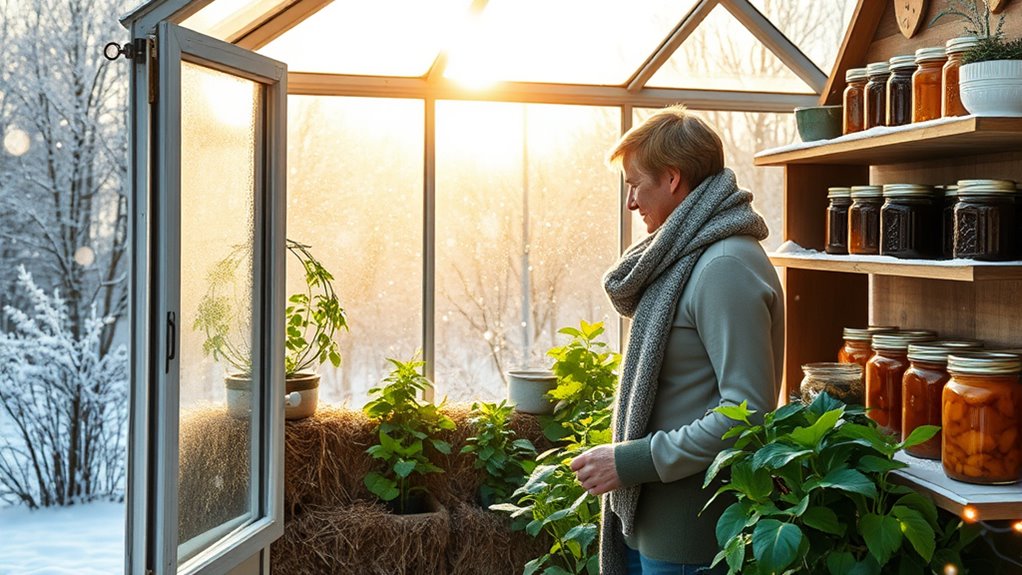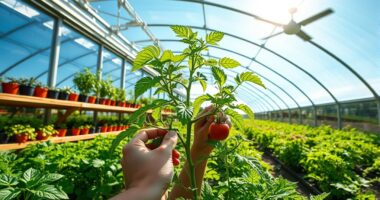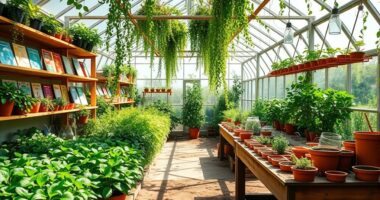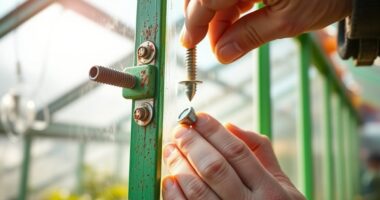To winterize your greenhouse, start by inspecting the structure for cracks and leaks, then clean and disinfect all surfaces. Insulate with materials like bubble wrap, and manage your water systems by draining and insulating pipes. Control pests by introducing beneficial insects and maintaining proper ventilation. Don't forget to monitor temperature and humidity, and keep your equipment in top shape. For more comprehensive tips on each step, you might want to explore further.
Key Takeaways
- Inspect and repair any damaged glazing, seals, and framing to ensure proper insulation and prevent cold air ingress.
- Clean and disinfect all surfaces, tools, and equipment to eliminate pests and diseases before winter.
- Properly insulate exposed pipes and greenhouse structures to minimize heat loss and protect your water systems.
- Maintain ventilation by keeping vents open and ensuring fans operate effectively to prevent humidity buildup.
- Regularly monitor temperature and humidity levels, adjusting as needed to create optimal growing conditions during the winter months.
Preparing the Greenhouse Structure
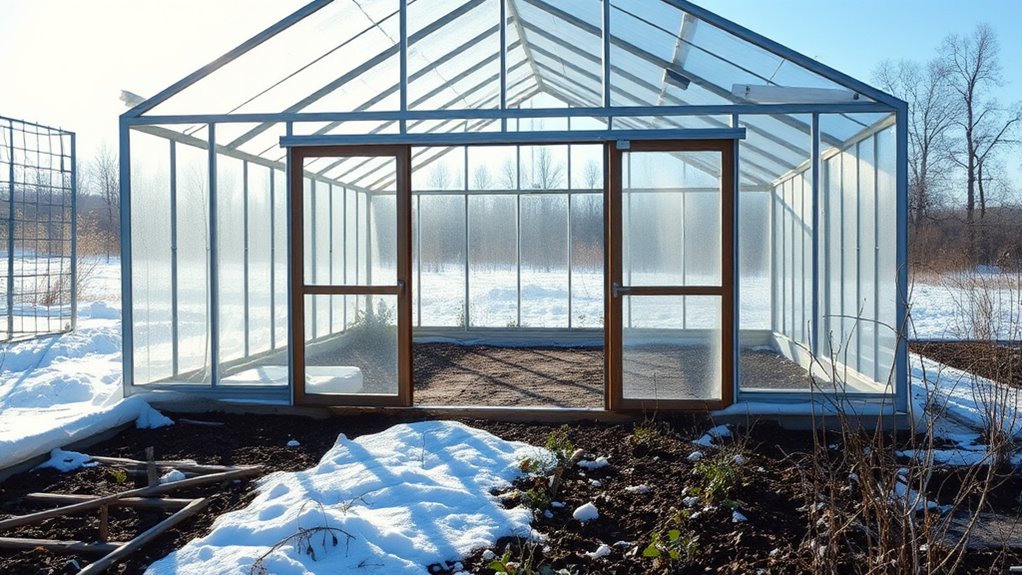
Before the cold weather sets in, it's crucial to prepare your greenhouse structure to ensure it can withstand winter conditions.
Start by inspecting the glazing for cracks or clouding, replacing any damaged panels. Check the seals and framing for gaps or rot, and re-caulk as needed. Test doors, vents, and louvers to ensure they operate smoothly and close tightly.
Next, examine the foundation for any sinking or cracks. Assess the overall structure for loose screws or corrosion. As you evaluate the cladding, seal any gaps and replace damaged panels. Additionally, ensure the cladding material can withstand local weather conditions to prevent cold air and pests infiltration.
Finally, consider upgrading to more durable materials to enhance insulation and protect against harsh elements. Taking these steps now will help keep your greenhouse safe and functional through winter.
Cleaning and Disinfecting
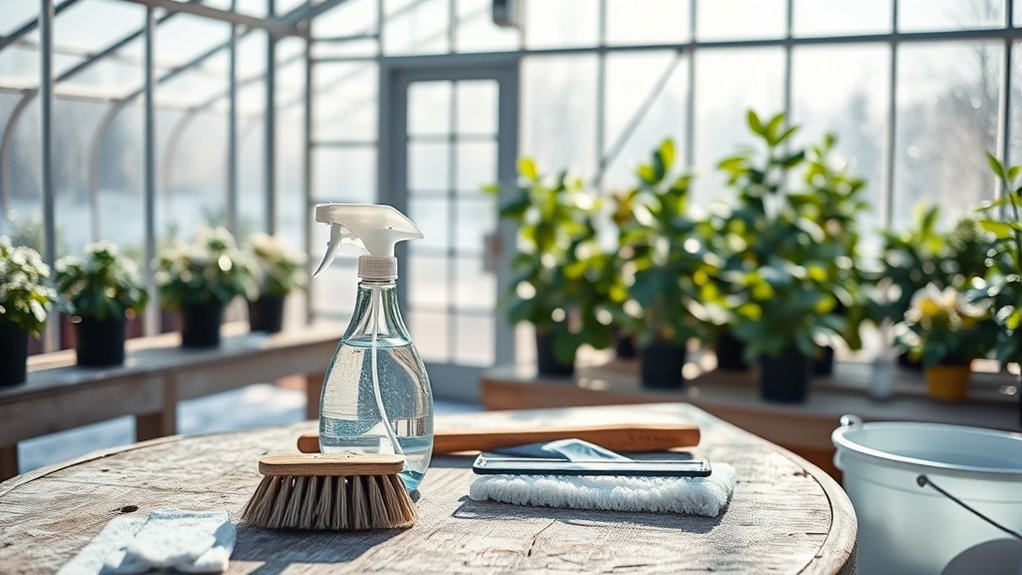
Cleaning and disinfecting your greenhouse is essential for creating a healthy environment for your plants during the winter months.
Start by removing all debris, including weeds, unhealthy plants, and organic matter. Use a shop vacuum or broom to clean the floors and surfaces, then power wash them with low pressure to eliminate grime and algae. Apply a gentle, natural soap to avoid harmful residues. Additionally, maintaining a clean greenhouse helps to prevent insects and diseases that could thrive in your plants' environment.
Remove all debris, then clean surfaces with a vacuum or broom before power washing to eliminate grime and algae.
Next, disinfect surfaces using a diluted bleach solution or hydrogen dioxide products.
Don't forget to clean and disinfect your tools and equipment, soaking irrigation parts in disinfectant. Regularly inspect for pests and follow proper waste disposal methods to prevent reintroduction.
Establish a cleaning schedule to maintain a clean greenhouse throughout winter.
Insulation and Heating
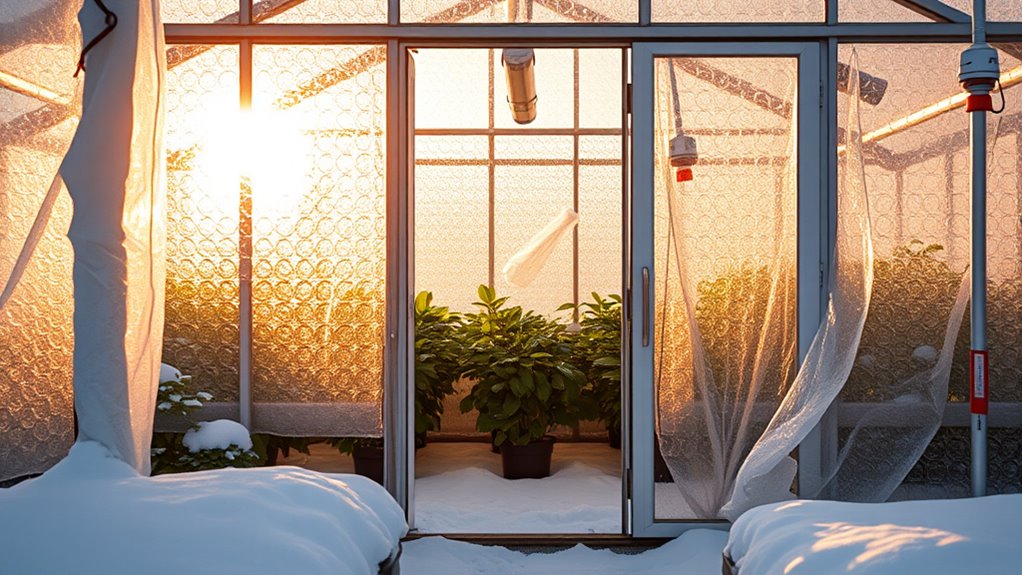
As winter approaches, ensuring your greenhouse is well-insulated and heated is crucial for maintaining a stable environment for your plants.
Start by choosing effective insulation materials like bubble wrap or twin-wall polycarbonate, which can significantly reduce heating costs while retaining heat. Utilizing frost blankets can be an additional strategy to protect crops during colder nights and enhance insulation without affecting the structure. Seal the base and cover any unused end-wall openings to minimize air transfer.
For heating, consider installing greenhouse heaters and using thermal mass, such as water containers, to store heat. Automated heat retention curtains can further enhance efficiency.
In colder climates, focus on higher R-value materials, while in warmer areas, ensure proper ventilation to prevent overheating.
Managing Water Systems
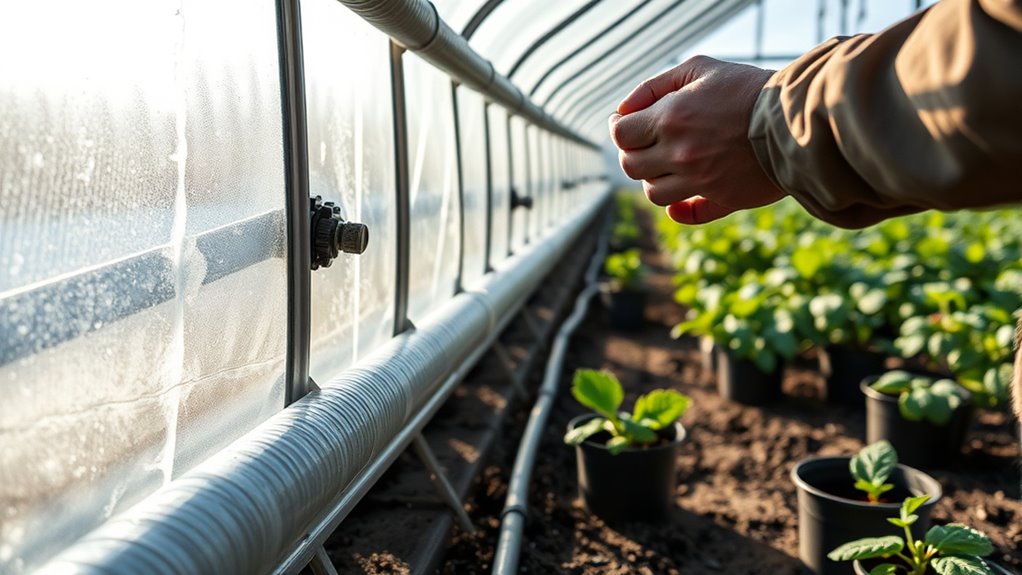
When winter arrives, managing your greenhouse's water systems becomes essential to prevent damage from freezing temperatures.
Start by turning off the main water supply and removing components like timers and filters, storing them indoors. Open valves at low points to manually drain the system, or use automatic drain valves if you have them. To ensure complete drainage, consider installing flush valves at low points to effectively aid in this process.
For thorough drainage, consider the blow-out method with compressed air. Insulate exposed pipes and drain hoses from outdoor faucets to protect against freezing. Seal open lines to keep debris out, and inspect for leaks before winter starts.
Adjust your watering schedule to minimize moisture in the soil, and use drip irrigation to reduce waste and freezing risks. Store hoses in a protected area.
Pest Control and Ventilation
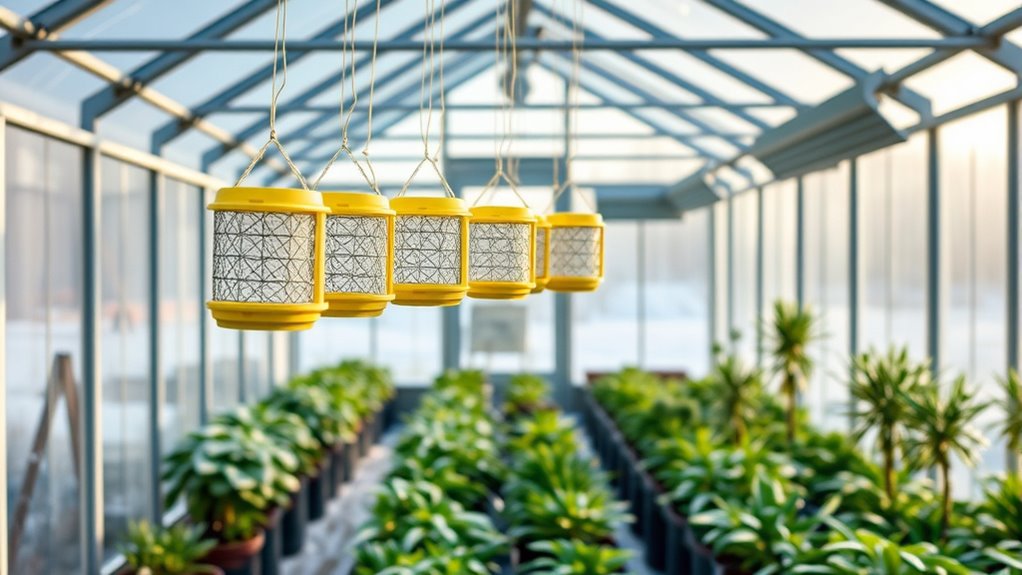
To keep your greenhouse healthy during winter, effective pest control and proper ventilation are crucial.
Start by maintaining airflow; keep vents partially open and run circulating fans to stabilize temperature and humidity. Regularly check your ventilation systems to ensure they're functioning properly.
For pest control, use Fungus Fly Killer Nematodes to tackle larvae in compost and Dragonfli Plant Soap for aphids. Introduce beneficial insects like green lacewings and ladybugs to manage pests naturally. Beneficial insects struggle to reproduce in unfavorable winter conditions, making it even more important to monitor pest levels closely.
Don't forget to clean your greenhouse thoroughly to eliminate potential pest habitats.
Monitor conditions daily with thermometers and hygrometers, adjusting humidity with humidifiers or gravel trays as needed.
With these strategies, you'll create a thriving winter environment for your plants.
Overwintering Plants
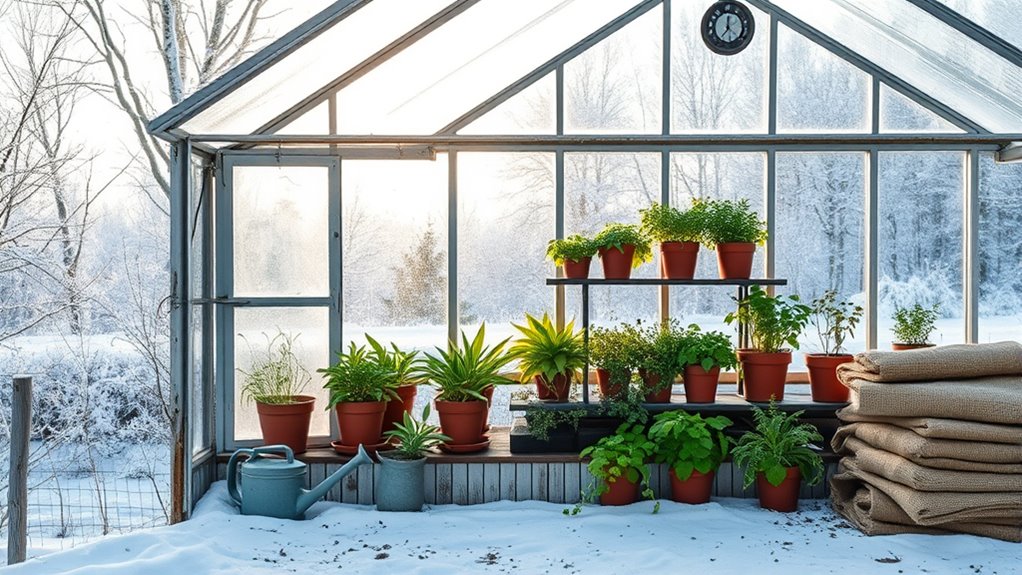
Overwintering plants requires careful preparation to ensure they thrive during the colder months. Start by selecting healthy plants; some may benefit from a final feeding before dormancy. Inspect plants for overall health before moving them indoors, and remove any unhealthy plants to prevent issues later. Prune early to promote growth and prevent disease. Mulch around plants to retain moisture and regulate soil temperature. Water them well before winter, but avoid overwatering to prevent root rot.
For added protection, consider using frost shields or blankets, as proper insulation can significantly improve plant survival rates. Choose hardy varieties like kale and chard, and move tender perennials into the greenhouse. Allow plants to go dormant naturally, as some will die back but regrow in spring. Finally, remember to consider your plant hardiness zone when selecting varieties for overwintering.
Monitoring Temperature and Humidity
Successfully overwintering your plants sets the stage for effective monitoring of temperature and humidity within your greenhouse.
Aim to keep temperatures between 60°F and 80°F during the day, with slightly cooler nights. Installing critical temperature alert systems like Sensaphone or Temp Stick helps you react quickly when temperatures become unsafe. Controlled temperature is crucial for plant yield and health, making it essential to monitor closely.
Place sensors strategically at each end and the middle of your greenhouse for accurate readings, especially during those chilly winter nights.
For humidity, maintain levels between 50% and 70%, using tools like sling psychrometers. Ventilation and heating will help reduce excess humidity, preventing diseases.
Maintaining Greenhouse Equipment
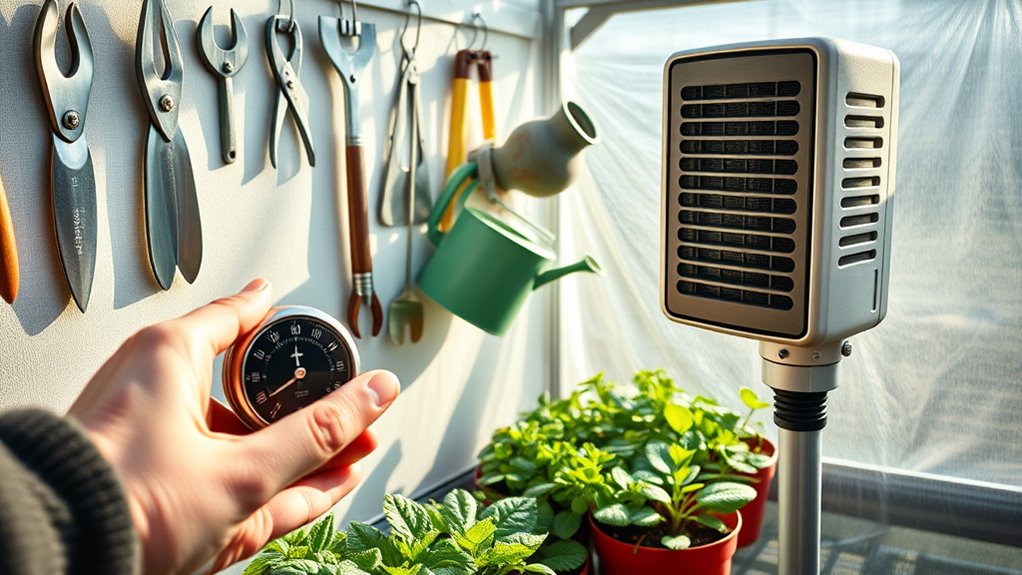
Ensure your greenhouse equipment is in top shape for the winter months ahead. Start by cleaning your furnace and replacing the filters to maintain efficiency. Regular maintenance ensures equipment longevity and optimal greenhouse operation. Don't forget to lubricate the pumps and motor bearings to prevent wear, and check fan belts for any signs of damage. Inspect gas valves and ignition mechanisms, running a combustion efficiency test to optimize energy use. Additionally, consider implementing energy-efficient systems to further reduce operational costs.
Next, examine your ventilation system. Ensure vent doors close properly and lubricate vent racks for smooth operation. Check electrical and plumbing systems for any corrosion or leaks, and test backup generators.
Finally, service your cooling systems by cleaning tanks and inspecting fans.
Frequently Asked Questions
How Often Should I Monitor My Greenhouse During Winter?
Imagine you're growing delicate orchids in your greenhouse. To keep them thriving during winter, you should monitor your greenhouse daily.
Daily checks help you catch any temperature or humidity issues early. Weekly reviews of logs ensure stability, while monthly inspections maintain structural integrity.
Don't forget seasonal adjustments to heating and lighting! By staying proactive, you'll create the ideal environment for your plants, preventing problems before they arise.
Keep those orchids happy!
What Types of Plants Are Best for Winter Growing?
If you're looking to grow in winter, consider cold-hardy options like carrots, beets, and parsnips.
Leafy greens like kale, spinach, and Swiss chard thrive in cooler temperatures.
Don't forget herbs—mint, parsley, and chives can withstand the chill, too.
For something different, try Brussels sprouts and broccoli, which can flourish in winter conditions.
With the right choices, you can enjoy fresh produce all season long!
Can I Use Grow Lights in Winter?
Absolutely, you can use grow lights in winter!
Think of them as a warm hug for your plants during the chilly months. They enhance growth by providing consistent light, crucial for photosynthesis.
With various types like LED and fluorescent, you can tailor the spectrum to your plants' needs. Plus, they're energy-efficient, making them a smart choice for keeping your greenhouse thriving all year.
How Can I Prevent Snow Accumulation on the Roof?
To prevent snow accumulation on your roof, consider installing diagonal braces for stability and using snow removal techniques like a roof rake.
If you're in a snowy area, choose a peaked roof design, as it sheds snow better.
Regularly inspect your structure for weaknesses, and remove snow promptly, starting from the middle.
If needed, install gutter heaters to help manage snow melt effectively and protect your greenhouse from potential damage.
What Are Signs of Plant Stress in Winter?
In winter, you'll notice signs of plant stress like leaf discoloration, wilting, and bud drop.
If temperatures drop too low, you might see frost damage or stunted growth.
Pay attention to humidity; high levels can cause mold, while low humidity leads to crispy leaf edges.
Overwatering can result in root rot, so make sure you're not drowning your plants.
Regularly check for pests, as stressed plants are more vulnerable to infestations.
Conclusion
By winterizing your greenhouse, you're not just protecting your plants; you're creating a cozy sanctuary, much like wrapping a beloved gift in warm, colorful paper. With proper insulation, cleaning, and monitoring, you'll ensure your greenhouse thrives even in the coldest months. Remember, a little preparation goes a long way in keeping your green oasis alive and flourishing. Embrace the chill, and watch your plants flourish as they bask in their winter haven.
